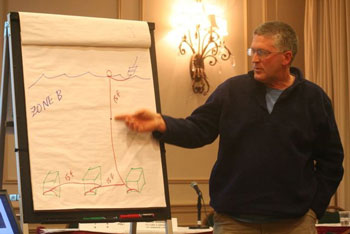Sinking Line Formula and Deployment Still Experimental
by Laurie Schreiber

Gulf of Maine Lobster Foundation Project Director Laura Ludwig listens to input from fishermen about their experiments with sinking line. Laurie Schreiber Photo
Lobster fishermen continue to have trouble with abrasion, parting and, ultimately, loss of their groundline and traps.
In 2009, a new federal law required the industry to switch from floating groundline to sinking groundline. The switch was made in an effort to protect endangered whales, which were at risk of getting snagged by groundline that floated upward in the water column.
But Maine fishermen have said that the sinking line is a problem along the portions of the coast where the bottom is rocky. They have said the rope chafes on the rocks and therefore has a much shorter life. They’ve said that, when it breaks underwater, they have no way to retrieve their gear. And they’ve said the rope gets snagged on the rocks, putting the boat and crew at risk.
As a result, many fishermen have been experimenting with the deployment of sinking line in order to maximize its life and save their gear, according to information that was shared at a session called ““Surviving the Whale Rules” at the Maine Fishermen’s Forum on March 3-5.
At that session, fishermen also heard that manufacturers of the rope, which is used to tether lobster traps together on the sea bottom, continue to experiment to create an abrasion-resistant formula.
The session brought together experts including lobstermen, whale researchers, rope engineers and manufacturers to better understand the operational, economic and safety challenges lobstermen face each day as a result the whale regulations.
Gulf of Maine Lobster Founda-tion Project Director Laura Ludwig said the foundation has been gathering information from fishermen about their own experiments with sinking line, in their efforts to make it more effective.
“It’s been a really interesting conversation to put people in the same room and say, ‘Huh, that might be a good idea,’” Ludwig said.
In June 2010, the foundation convened a groundline workshop which brought together lobstermen and seven rope manufacturers, including HyLiner, Polysteel Atlantic, SeaSide, Anacko, Orion and Novatec Braids.
The workshop was designed as a forum for lobstermen to discuss the changes they had made in their fishing techniques in order to fish with new line produced by the manufacturers, Ludwig said.
Fishermen brought samples of used sinking groundline to demonstrate the abrasion from use on the rocky bottom. Many of the samples, she said, had been used for less than a year, yet had chafed or parted, often resulting in trap loss.
“We wanted to get lobstermen from each zone talking with rope manufacturers about the rope they were using,” she said. “A lot of rope samples were brought in for discussion purposes. Being able to look at rope that was actually fished for certain period of time, and different areas, was instructive – basically making the point that you never know when it’s going to part.”
According to Ludwig, many fishermen at the workshop had begun to try different methods for rigging their traps and rope – using, for example, different lengths of rope and different ways of tying it to the traps, so as to avoid chafing. Some fishermen, she said, were trying to find less-rocky fishing bottom.
“We also had a couple of ideas for developing customized lines,” she said. “There was a next-step effort to improve on the product, based on input from the industry.”
Ludwig said she’s also been utilizing the state’s trap tag replacement program as a way to study trap loss, which may be an indication of problems with sinking line.
In 2009, the Department of Marine Resources instituted a program which required fishermen to submit an affidavit to request new tags for replacement traps. Fishermen are required to attached identification tags to each of their traps. If traps are lost and they want to replace them, they must go to the DMR to get more tags. Since 2009, they have been required to provide affidavits that provide the reason they lost the trap tags and the day and location the loss occurred.
“We were able to look at the information the fishermen had provided to the Marine Patrol about the reasons why they lost their traps,” she said. “A lot of people have a good idea of why they lose their traps, and that comes out in these affidavits. This is not a thorough-going look at how many traps are lost, but only how many traps are replaced.”
In 2009, she said, the reasons listed for trap loss were sinking rope, boat traffic, mobile gear interactions, weather, trap molesting, and other unknown reasons. The density of trap loss due to sinking rope was highest Down East, she said.
“Down East is a real challenge for a lot of folks who are fishing a certain configuration,” she said. “There’s a lot of confirmation of the assumption that the rope is harder used Down East.”

Southwest Harbor fisherman David Horner discusses sinking line configuration at a session called “Surviving the Whale Rules” at the Maine Fishermen’s Forum on March 3-5. Laurie Schreiber Photo
Ludwig said she’s also been talking with quite a few fishermen about their experience with sinking line. She said she aims to gather as much information as possible—ideally, when fishermen are actually fishing.
Ludwig reported that some fishermen have said that they are doing fine with sink rope.
“I don’t know if there’s a different pace that people haul, if the equipment is different, if the bottom is different, the rope they choose to use, how they rig their gear,” she said. “That’s what we want to talk about.”
Still, she said, the feedback is contradictory. For example, “A few times I’ve heard, ‘Breakaways are the best thing that have ever happened to us. I also hear, ‘Breakaways are the worst thing that ever happened.’ What’s the difference between someone who’s actually happy about it and someone who’s having a frustrating time? What kind of information would a person be able to share that would solve a problem for somebody else?”
Given the negative publicity around sinking line, she said, some fishermen who have not had problems are perplexed.
“‘I haven’t lost any traps’—that’s sort of said with a head-scratching,” she said. “Usually, that tends to happen for folks who move off hard bottom or they’re fishing in an area that’s not as challenging to the rope; perhaps there’s not as much current or hard bottom. Or they’ve made some adjustments to get to that point.”
Several fishermen discussed changes they made to their gear configuration or fishing practices.
Cushing fisherman Mike Myrick and southern Maine fisherman Jason Mitschele both said chafing has been a problem that they’ve tried to correct either by shortening up the line or fishing on different bottom. The new sinking rope is also more expensive than the old floating line, Mitschele said.
Others said they’ve either tied or clipped their ropes in different ways to their traps, in order to minimize movement on the bottom. And some said they’re using thicker rope.
